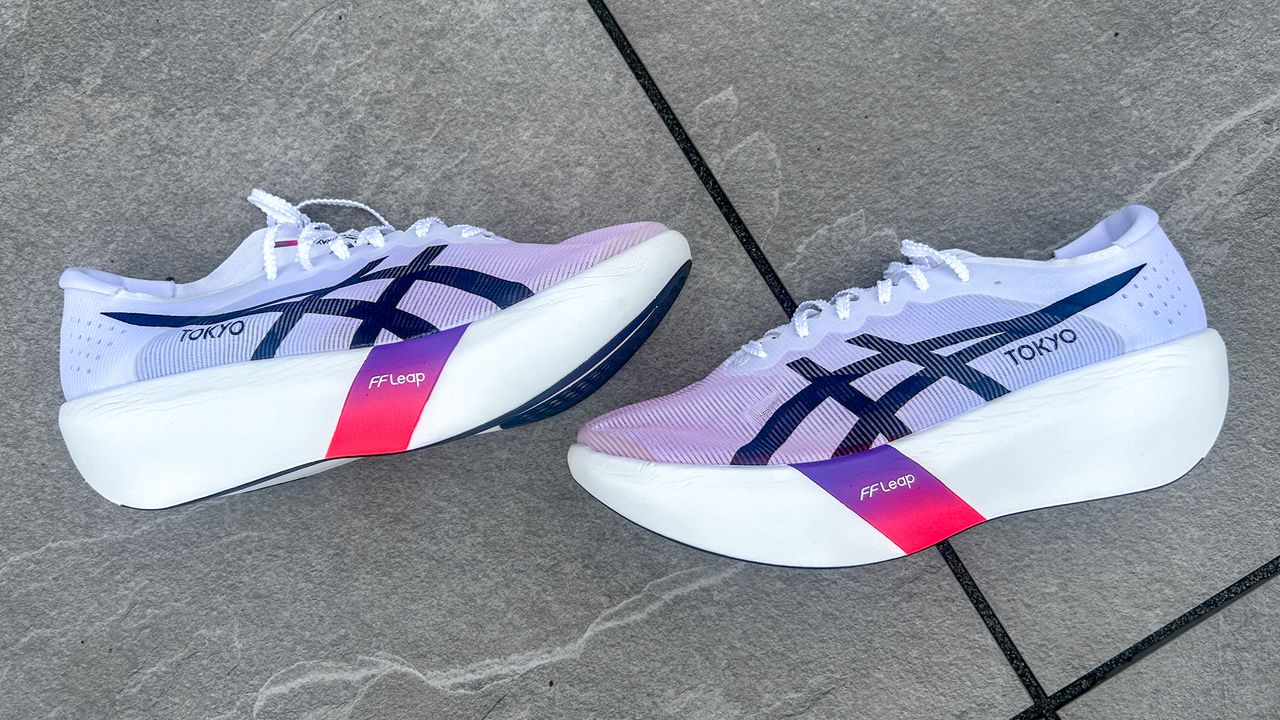
There are a lot of reasons to ignore the Asics Metaspeed Ray, even if you’re a seasoned runner keen to buy the best carbon plate running shoes for your races.
It’s expensive, it’s not stable or durable. Asics has two other great racers in its range that are cheaper, and the Metaspeed Ray doesn’t even have a full-length carbon plate.
Overriding all these objections, however, is how the Metaspeed Ray feels on the run. It’s a dream to run fast thanks to its featherweight design and springy midsole foam.
That might not be enough to make it a sensible buy, but I’ve had too much fun in the Asics Metaspeed Ray to say you should ignore this shoe entirely, even if there might be smarter options on the market to consider first.
Asics Metaspeed Ray review: Price and availability

The Asics Metaspeed Ray was announced in May 2025 and went on sale in August 2025. It costs $300 / £265, making it Asics’s most expensive racing shoe to date, with Asics Metaspeed Sky Tokyo and Edge Tokyo shoes costing $270 / £240.
Its price is not wildly out of line compared with carbon shoes from other brands, though, especially when you consider that Adidas charges $500 for the super-light shoe in its range — the Adidas Adizero Adios Pro Evo 2.
Asics Metaspeed Ray review: Design and fit

The Asics Metaspeed Ray is only available in the white color I tested at the moment. It fit me well in my normal running shoe size, the same size I wear for the Metaspeed Tokyo racing shoes, though it is a little narrow in the midfoot.
Despite a lofty stack height of 39.5mm at the heel and 34.5mm at the forefoot, the Metaspeed Ray weighs just 4.8oz in my US men’s size 10. That’s over an ounce lighter than other super-light shoes like the Puma Fast-R Nitro Elite 3 and Asics Metaspeed Sky Tokyo, and almost 3oz lighter than the Nike Alphafly 3.
Upper

The Metaspeed Ray has a very thin Matryx upper that creates a barely-there feel while still holding the foot securely enough for fast running.
As with most elements of the shoe, the upper is built for speed, not durability, and the lightweight material needs to be treated with care, but I’ve not seen any worrying signs of wear after 40 miles.
Midsole

The FF Leap foam in the midsole of the Asics Metaspeed Ray is the lightest, softest and bounciest foam in the brand’s range. While the Metaspeed Tokyo shoes use FF Leap alongside firmer FF Turbo+ foam in their midsoles, it’s all FF Leap in the Metaspeed Ray, making it softer and springier than the Tokyo shoes.
There is also only a half-length carbon plate in the Metaspeed Ray’s midsole, which sits under the forefoot and midfoot of the shoe. This helps reduce weight, but makes the heel even softer and less stable.
Outsole

The thin AsicsGrip rubber on the outsole of the Metaspeed Ray is used very sparingly, and while the forefoot is mostly covered, along with some sections of the heel, there is a lot of exposed foam on the bottom of the shoe.
This is already showing signs of wear from my testing, especially around the heel and the exposed section of the forefoot. It isn’t affecting performance, and I’ve not had any problems with the grip of the Metaspeed Ray despite its minimal outsole, but it won't be as long-lasting as shoes with thicker outsoles.
Asics Metaspeed Ray review: Running performance

Despite being a big fan of the Asics Metaspeed Sky Paris and Sky Tokyo, I wasn’t sure that I would get on with the Metaspeed Ray. It’s a pinnacle product that seems aimed at elite athletes, and the half-length carbon plate also suggests it’s built for forefoot strikers.
I’m pretty quick for an amateur, but far from elite, and I heel strike, so I worried the soft foam at the back of the shoe and the lack of a plate underfoot would make it very unstable for me.
It is wobbly, that’s for sure. I am a neutral runner but can see that I overpronate — my foot rolls inward — when I run in the Metaspeed Ray. It’s very soft at the heel, and I would worry about how my running form would look in the shoe at the end of a long event like a marathon.

All that said, this is the most fun I’ve had in any racing shoe this year, and I’ve found running at fast speeds feels close to effortless at times in the Metapeed Ray. On two long tempo runs, one at a 6-minute/mile pace and one at my marathon pace of 5:30/mile, I found it notably easier to hold the pace in the Metaspeed Ray than in other shoes, and my heart rate was also lower.
That’s even in comparison to the Metaspeed Sky Tokyo, which is a brilliant racing shoe itself. The Metaspeed Ray is so light and springy, I felt like I was flying along at those paces, and I also loved it for short track reps at more like 5K and 10K pace.
The question remains, will it still feel as fun to be in a shoe this soft in the second half of a long race, when I might prefer the extra stability of a shoe with a full plate, like the Metaspeed Sky Tokyo or Puma Fast-R 3?
It’s a question I intend to answer when I next get a chance to do a long race. For now, I’m wrapping my Metaspeed Rays in cotton-wool, because they’re already showing a little more wear than is ideal after 40 miles.
Should you buy the Asics Metaspeed Ray?

Even after logging a lot of fast miles in the Asics Metaspeed Ray, I’m a bit torn on it. It’s a terrific shoe that makes fast runs feel easier, but also highly unstable and not that durable.
If you have the budget to give it a go, then it’s a speedy delight that stands out even in the crowded super-shoe market, but there are better value racing shoes that might well be more effective for most runners.
These include the Asics Metaspeed Sky Tokyo, which is almost as bouncy and light, but also more stable thanks to its full-length plate (though still pretty unstable itself), and the Puma Fast-R 3, which has a firmer, more rockered ride, but is also incredibly fast.
The Saucony Endorphin Elite 2 is a slightly more accessible shoe for those who want a very soft foam in the midsole of their racer. It’s also unstable, though not as dramatically so as the Metaspeed Ray, and not as light and impressive as the Asics shoe, but it has a highly bouncy and fast ride.







